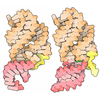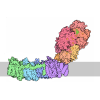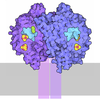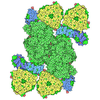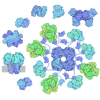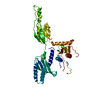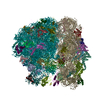[English] 日本語
 Yorodumi
Yorodumi- PDB-3jah: Structure of a mammalian ribosomal termination complex with ABCE1... -
+ Open data
Open data
- Basic information
Basic information
| Entry | Database: PDB / ID: 3jah | ||||||
|---|---|---|---|---|---|---|---|
| Title | Structure of a mammalian ribosomal termination complex with ABCE1, eRF1(AAQ), and the UAG stop codon | ||||||
 Components Components |
| ||||||
 Keywords Keywords | RIBOSOME / termination / eRF1 / ABCE1 | ||||||
| Function / homology |  Function and homology information Function and homology informationregulation of macromolecule metabolic process / translation termination factor activity / translation release factor complex / cytoplasmic translational termination / regulation of translational termination / translation release factor activity, codon specific / protein methylation / translation release factor activity / sequence-specific mRNA binding / ribosomal subunit ...regulation of macromolecule metabolic process / translation termination factor activity / translation release factor complex / cytoplasmic translational termination / regulation of translational termination / translation release factor activity, codon specific / protein methylation / translation release factor activity / sequence-specific mRNA binding / ribosomal subunit / peptidyl-tRNA hydrolase activity / nuclear-transcribed mRNA catabolic process, nonsense-mediated decay / Protein hydroxylation / Eukaryotic Translation Termination / ubiquitin ligase inhibitor activity / positive regulation of signal transduction by p53 class mediator / Nonsense Mediated Decay (NMD) independent of the Exon Junction Complex (EJC) / 90S preribosome / phagocytic cup / Nonsense Mediated Decay (NMD) enhanced by the Exon Junction Complex (EJC) / translational termination / ribosomal small subunit export from nucleus / rough endoplasmic reticulum / translation regulator activity / gastrulation / MDM2/MDM4 family protein binding / cytosolic ribosome / class I DNA-(apurinic or apyrimidinic site) endonuclease activity / DNA-(apurinic or apyrimidinic site) lyase / ribosomal large subunit biogenesis / maturation of LSU-rRNA from tricistronic rRNA transcript (SSU-rRNA, 5.8S rRNA, LSU-rRNA) / positive regulation of apoptotic signaling pathway / maturation of SSU-rRNA from tricistronic rRNA transcript (SSU-rRNA, 5.8S rRNA, LSU-rRNA) / maturation of SSU-rRNA / small-subunit processome / Regulation of expression of SLITs and ROBOs / spindle / rRNA processing / rhythmic process / positive regulation of canonical Wnt signaling pathway / regulation of translation / large ribosomal subunit / ribosome biogenesis / ribosome binding / ribosomal small subunit biogenesis / ribosomal small subunit assembly / small ribosomal subunit / 5S rRNA binding / ribosomal large subunit assembly / small ribosomal subunit rRNA binding / large ribosomal subunit rRNA binding / cytosolic small ribosomal subunit / perikaryon / cytosolic large ribosomal subunit / cytoplasmic translation / cell differentiation / tRNA binding / mitochondrial inner membrane / postsynaptic density / rRNA binding / structural constituent of ribosome / ribosome / translation / ribonucleoprotein complex / cell division / DNA repair / mRNA binding / apoptotic process / synapse / dendrite / centrosome / nucleolus / perinuclear region of cytoplasm / endoplasmic reticulum / Golgi apparatus / ATP hydrolysis activity / DNA binding / RNA binding / zinc ion binding / ATP binding / nucleus / membrane / cytoplasm / cytosol Similarity search - Function | ||||||
| Biological species |  Homo sapiens (human) Homo sapiens (human) | ||||||
| Method | ELECTRON MICROSCOPY / single particle reconstruction / cryo EM / Resolution: 3.45 Å | ||||||
 Authors Authors | Brown, A. / Shao, S. / Murray, J. / Hegde, R.S. / Ramakrishnan, V. | ||||||
 Citation Citation |  Journal: Nature / Year: 2015 Journal: Nature / Year: 2015Title: Structural basis for stop codon recognition in eukaryotes. Authors: Alan Brown / Sichen Shao / Jason Murray / Ramanujan S Hegde / V Ramakrishnan /  Abstract: Termination of protein synthesis occurs when a translating ribosome encounters one of three universally conserved stop codons: UAA, UAG or UGA. Release factors recognize stop codons in the ribosomal ...Termination of protein synthesis occurs when a translating ribosome encounters one of three universally conserved stop codons: UAA, UAG or UGA. Release factors recognize stop codons in the ribosomal A-site to mediate release of the nascent chain and recycling of the ribosome. Bacteria decode stop codons using two separate release factors with differing specificities for the second and third bases. By contrast, eukaryotes rely on an evolutionarily unrelated omnipotent release factor (eRF1) to recognize all three stop codons. The molecular basis of eRF1 discrimination for stop codons over sense codons is not known. Here we present cryo-electron microscopy (cryo-EM) structures at 3.5-3.8 Å resolution of mammalian ribosomal complexes containing eRF1 interacting with each of the three stop codons in the A-site. Binding of eRF1 flips nucleotide A1825 of 18S ribosomal RNA so that it stacks on the second and third stop codon bases. This configuration pulls the fourth position base into the A-site, where it is stabilized by stacking against G626 of 18S rRNA. Thus, eRF1 exploits two rRNA nucleotides also used during transfer RNA selection to drive messenger RNA compaction. In this compacted mRNA conformation, stop codons are favoured by a hydrogen-bonding network formed between rRNA and essential eRF1 residues that constrains the identity of the bases. These results provide a molecular framework for eukaryotic stop codon recognition and have implications for future studies on the mechanisms of canonical and premature translation termination. | ||||||
| History |
|
- Structure visualization
Structure visualization
| Movie |
 Movie viewer Movie viewer |
|---|---|
| Structure viewer | Molecule:  Molmil Molmil Jmol/JSmol Jmol/JSmol |
- Downloads & links
Downloads & links
- Download
Download
| PDBx/mmCIF format |  3jah.cif.gz 3jah.cif.gz | 5.6 MB | Display |  PDBx/mmCIF format PDBx/mmCIF format |
|---|---|---|---|---|
| PDB format |  pdb3jah.ent.gz pdb3jah.ent.gz | Display |  PDB format PDB format | |
| PDBx/mmJSON format |  3jah.json.gz 3jah.json.gz | Tree view |  PDBx/mmJSON format PDBx/mmJSON format | |
| Others |  Other downloads Other downloads |
-Validation report
| Arichive directory |  https://data.pdbj.org/pub/pdb/validation_reports/ja/3jah https://data.pdbj.org/pub/pdb/validation_reports/ja/3jah ftp://data.pdbj.org/pub/pdb/validation_reports/ja/3jah ftp://data.pdbj.org/pub/pdb/validation_reports/ja/3jah | HTTPS FTP |
|---|
-Related structure data
| Related structure data |  3039MC  3038C  3040C  3jagC  3jaiC M: map data used to model this data C: citing same article ( |
|---|---|
| Similar structure data |
- Links
Links
- Assembly
Assembly
| Deposited unit | 
|
|---|---|
| 1 |
|
- Components
Components
+Protein , 77 types, 77 molecules ABCDEFGHIJLMNOPQRSTUVWXYZabcde...
-Protein/peptide , 3 types, 3 molecules ln1
| #37: Protein/peptide | Mass: 6295.562 Da / Num. of mol.: 1 / Source method: isolated from a natural source / Source: (natural)  |
|---|---|
| #39: Protein/peptide | Mass: 3213.075 Da / Num. of mol.: 1 / Source method: isolated from a natural source / Source: (natural)  |
| #45: Protein/peptide | Mass: 1788.032 Da / Num. of mol.: 1 / Source method: isolated from a natural source / Source: (natural)  |
-RNA chain , 7 types, 7 molecules 235789hh
| #46: RNA chain | Mass: 24436.551 Da / Num. of mol.: 1 / Source method: isolated from a natural source / Source: (natural)  |
|---|---|
| #47: RNA chain | Mass: 24102.275 Da / Num. of mol.: 1 / Source method: isolated from a natural source / Source: (natural)  |
| #48: RNA chain | Mass: 1186579.500 Da / Num. of mol.: 1 / Source method: isolated from a natural source / Source: (natural)  |
| #49: RNA chain | Mass: 38691.914 Da / Num. of mol.: 1 / Source method: isolated from a natural source / Source: (natural)  |
| #50: RNA chain | Mass: 50143.648 Da / Num. of mol.: 1 / Source method: isolated from a natural source / Source: (natural)  |
| #51: RNA chain | Mass: 554751.312 Da / Num. of mol.: 1 / Source method: isolated from a natural source / Source: (natural)  |
| #85: RNA chain | Mass: 3837.328 Da / Num. of mol.: 1 / Source method: isolated from a natural source / Source: (natural)  |
-Non-polymers , 4 types, 207 molecules 

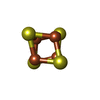




| #88: Chemical | ChemComp-MG / #89: Chemical | ChemComp-ZN / #90: Chemical | #91: Chemical | |
|---|
-Details
| Has protein modification | Y |
|---|
-Experimental details
-Experiment
| Experiment | Method: ELECTRON MICROSCOPY |
|---|---|
| EM experiment | Aggregation state: PARTICLE / 3D reconstruction method: single particle reconstruction |
- Sample preparation
Sample preparation
| Component |
| ||||||||||||||||||||||||||||||||||||||||
|---|---|---|---|---|---|---|---|---|---|---|---|---|---|---|---|---|---|---|---|---|---|---|---|---|---|---|---|---|---|---|---|---|---|---|---|---|---|---|---|---|---|
| Buffer solution | Name: 50 mM HEPES, 100 mM potassium acetate, 5 mM magnesium acetate, 1 mM DTT pH: 7.4 Details: 50 mM HEPES, 100 mM potassium acetate, 5 mM magnesium acetate, 1 mM DTT | ||||||||||||||||||||||||||||||||||||||||
| Specimen | Embedding applied: NO / Shadowing applied: NO / Staining applied: NO / Vitrification applied: YES | ||||||||||||||||||||||||||||||||||||||||
| Specimen support | Details: Quantifoil R2/2 400 mesh Cu grid with thin continuous carbon support, glow discharged | ||||||||||||||||||||||||||||||||||||||||
| Vitrification | Instrument: FEI VITROBOT MARK III / Cryogen name: ETHANE / Humidity: 100 % Details: After 30 second wait time, blot for 3 seconds before plunging into liquid ethane (FEI VITROBOT MARK III). Method: After 30 second wait time, blot for 3 seconds before plunging |
- Electron microscopy imaging
Electron microscopy imaging
| Experimental equipment |  Model: Titan Krios / Image courtesy: FEI Company |
|---|---|
| Microscopy | Model: FEI TITAN KRIOS / Date: Feb 25, 2015 / Details: Automated data acquisition using EPU (FEI) |
| Electron gun | Electron source:  FIELD EMISSION GUN / Accelerating voltage: 300 kV / Illumination mode: FLOOD BEAM FIELD EMISSION GUN / Accelerating voltage: 300 kV / Illumination mode: FLOOD BEAM |
| Electron lens | Mode: BRIGHT FIELD / Nominal magnification: 59000 X / Calibrated magnification: 104478 X / Nominal defocus max: 3600 nm / Nominal defocus min: 1700 nm / Cs: 2.7 mm |
| Specimen holder | Specimen holder type: FEI TITAN KRIOS AUTOGRID HOLDER |
| Image recording | Electron dose: 30 e/Å2 / Film or detector model: FEI FALCON II (4k x 4k) |
| Image scans | Num. digital images: 1601 |
| Radiation wavelength | Relative weight: 1 |
- Processing
Processing
| EM software |
| ||||||||||||||||||||||||||||||||||||||||||
|---|---|---|---|---|---|---|---|---|---|---|---|---|---|---|---|---|---|---|---|---|---|---|---|---|---|---|---|---|---|---|---|---|---|---|---|---|---|---|---|---|---|---|---|
| Symmetry | Point symmetry: C1 (asymmetric) | ||||||||||||||||||||||||||||||||||||||||||
| 3D reconstruction | Resolution: 3.45 Å / Resolution method: FSC 0.143 CUT-OFF / Num. of particles: 20515 / Nominal pixel size: 1.34 Å / Actual pixel size: 1.34 Å / Symmetry type: POINT | ||||||||||||||||||||||||||||||||||||||||||
| Atomic model building |
| ||||||||||||||||||||||||||||||||||||||||||
| Atomic model building |
| ||||||||||||||||||||||||||||||||||||||||||
| Refinement step | Cycle: LAST
|
 Movie
Movie Controller
Controller


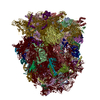
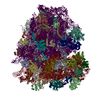
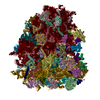


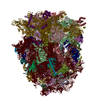




 PDBj
PDBj













